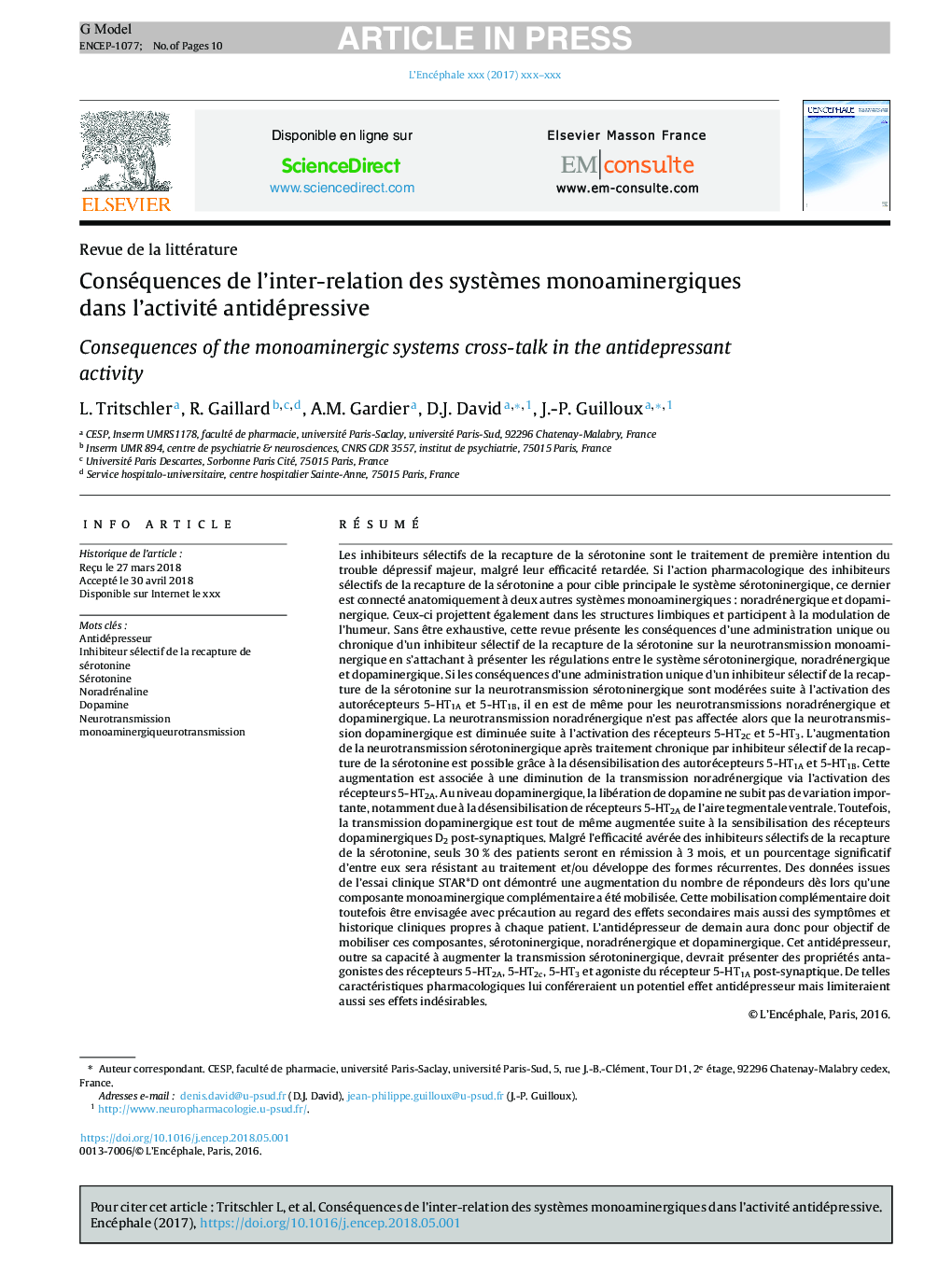| کد مقاله | کد نشریه | سال انتشار | مقاله انگلیسی | نسخه تمام متن |
|---|---|---|---|---|
| 8814664 | 1608027 | 2018 | 10 صفحه PDF | دانلود رایگان |
عنوان انگلیسی مقاله ISI
Conséquences de l'inter-relation des systèmes monoaminergiques dans l'activité antidépressive
دانلود مقاله + سفارش ترجمه
دانلود مقاله ISI انگلیسی
رایگان برای ایرانیان
کلمات کلیدی
موضوعات مرتبط
علوم پزشکی و سلامت
پزشکی و دندانپزشکی
روانپزشکی و بهداشت روانی
پیش نمایش صفحه اول مقاله

چکیده انگلیسی
Selective serotonin reuptake inhibitors (SSRIs) are the most prescribed antidepressant treatment for treat major depressive disorders. Despite their effectiveness, only 30% of SSRI-treated patients reach remission of depressive symptoms. SSRIs by inhibiting the serotonin transporter present some limits with residual symptoms. Increasing not only serotonin but also norepinephrine and dopamine levels in limbic areas seems to improve remission. Anatomical relationships across serotoninergic, dopaminergic and noradrenergic systems suggest tight reciprocal regulations among them. This review attempts to present, from acute to chronic administration the consequences of SSRI administration on monoaminergic neurotransmission. The serotonin neurons located in the raphe nucleus (RN) are connected to the locus coeruleus (locus coeruleus), the key structure of norepinephrine synthesis, through GABAergic-inhibiting interneurons. Activation of the 5-HT2A receptors expressed on GABAergic interneurons following SERT-inhibition induces an increase in serotonin leading to inhibitory effect on NE release. Similarly, the serotonin neurons exert negative regulation on dopaminergic neurons from the ventral tegmental area (VTA) through a GABAergic interneuron. These interneurons express the 5-HT2C and 5-HT3 receptors inducing an inhibitory effect of 5-HT on DA release. Positive reciprocal connections are also observed through direct projections from the locus coeruleus to the RN and from the VTA to the RN through α1 and D2 receptors respectively, both stimulating the serotoninergic activity. Acute SSRI treatment induces only a slight increase in 5-HT levels in limbic areas due to the activation of presynaptic 5-HT1A and 5-HT1B autoreceptors counteracting the effects of the transporter blockade. No change in NE levels and a small decrease in the dopaminergic neurotransmission is also observed. These weak changes in monoamine in the limbic areas after acute SSRI treatment seems to be one of key point involved in the onset of action. Following desensitization of the 5-HT1A and 5-HT1B autoreceptors, chronic SSRI treatment induces a large increase in the 5-HT neurotransmission. Changes in 5-HT levels at the limbic areas results in a decrease in NE transmission and an increase in DA transmission through an increase in the post-synaptic D2 receptors sensitivity and not from a change in DA levels, which is mainly due to a desensitization of the 5-HT2A receptor. The observed decrease of NE neurotransmission could explain some limits of the SSRI therapy and the interest to activate NE system for producing more robust effects. On the other hand, the D2 sensitization, especially in the nucleus accumbens, stimulates the motivation behavior as well as remission of anhedonia considering the major role of DA release in this structure. Finally, we need to take into account the key role of each monoaminergic neurotransmission to reach remission. Targeting only one system will limit the therapeutic effectiveness. Clinical evidences, including the STAR*D studies, confirmed this by an increase of the remission rate following the mobilization of several monoaminergic transmissions. However, these combinations cannot constitute first line of treatment considering the observed increase of side effects. Such an approach should be adapted to each patient in regard to its particular symptoms as well as clinical history. The next generation of antidepressant therapy will need to take into consideration the interconnections and the interrelation between the monoaminergic systems.
ناشر
Database: Elsevier - ScienceDirect (ساینس دایرکت)
Journal: L'Encéphale - Volume 44, Issue 3, June 2018, Pages 264-273
Journal: L'Encéphale - Volume 44, Issue 3, June 2018, Pages 264-273
نویسندگان
L. Tritschler, R. Gaillard, A.M. Gardier, D.J. David, J.-P. Guilloux,